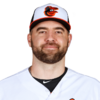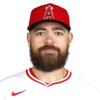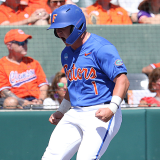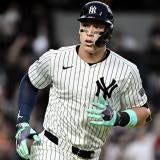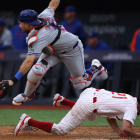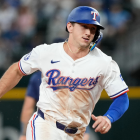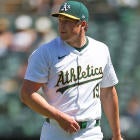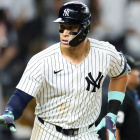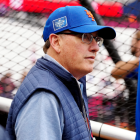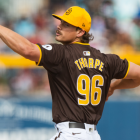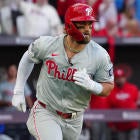In due time, Nathan Eovaldi is going to sign a lucrative multiyear contract. The free agent right-hander is receiving interest from a handful of teams, and he positioned himself to fulfill this destiny by throwing 111 high-quality innings this season, accumulating a 3.81 ERA and a career-high 5.05 strikeout-to-walk ratio. Add in his gutsy performance in Game 3 of the World Series (which assured his place in Red Sox lore), and it's hard to believe that a year ago Eovaldi was an afterthought.
Indeed, last November Eovaldi was working his way back from the Tommy John surgery that wiped out his 2017 season. He was still considered (when he was appraised at all) an underachiever, a tease. He could throw hard, but his results never matched his stuff. Hence his previous three seasons resulting in a 90 ERA+ (the average starter checks in around 93); hence Eovaldi's availability to the spending-averse Rays on a one-year deal with a club option.
After watching Eovaldi rewrite his narrative, it's tempting to look for the "next" him. That's a fool's errand. Stories like his seldom play out so neatly. Rather than waste our time with that exercise, we'll waste it by examining seven overlooked starting pitchers who remain on the younger side to see if there's any reason to believe they could improve their stock in 2019 -- not to Eovaldi's heights, but to the point where we can marvel at how they salvaged their careers.
Drew Hutchison used to be precocious. He debuted in the majors at 21 and was entrenched in the Blue Jays rotation within three seasons. Hutchison never lived up to his mid-rotation promise, however, and has pitched for five organizations the past three seasons. Most recently, he posted a 6.75 ERA in 42 innings split between the Phillies and Rangers.
While Hutchison pitched better with the Dodgers' Triple-A team and hits the open market this winter at a young 28, there isn't much left to dream on. His fastball clocked in at 90 mph with the Rangers, bottom-of-the-scale for a right-handed starter these days. To make matters worse, the pitch featured less movement than in the past. Hutchison's slider still generated whiffs on 30 percent of the swings taken against it, but that's about it so far as positives go.
Maybe Hutchison finds a new grip or arm slot that adds run or rise to his heater, or changes his training and conditioning regimen and adds some oomph.
The book on Nate Karns has been the same for years: He can't stay healthy.
To wit, Karns was limited to nine appearances in 2017 before undergoing season-ending surgery to correct thoracic outlet syndrome -- the same condition that derailed Matt Harvey's career, among others. He then missed all of 2018 due to elbow inflammation that saw him suffer repeated setbacks. Health is the great unknown -- especially from the outside looking in -- but suffering through just one of those physical ailments is concerning, both can be devastating.
Who knows then what the soon-to-turn-31 Karns has left? He showed in 41 starts between 2015-16 that he could become a No. 4 starter behind a good fastball-curve combination that made up for his lagging changeup and command. Whether that remains the case is beyond us. We wish him the best, but we're not optimistic for reasons that are out of his control.
It feels as though Jordan Lyles has been around longer than time itself. Not quite. He broke into the majors as a 20-year-old in 2011, and has since finished with an ERA north of 5.00 in six of his eight tries. Despite being a sub-replacement-level pitcher for his career, last season offered some evidence that there's more upside here than his past numbers indicate.
Always a premium athlete, Lyles tweaked his mechanics. The changes proved beneficial, permitting him to post both the highest average fastball velocity and strike percentage of his career. Lyles altered his pitch usage by leaning more on his spike curve -- the breadwinner of his arsenal as judged by whiff rate. Predictably, the result was a new career-best strikeout rate of nearly one per inning -- notable since he'd topped seven per nine just once before.
Lyles has spent the last several seasons primarily working out of relief. It's unclear if any team will provide him with the opportunity to start, but we're keeping an eye on him regardless.
Jeez, did Matt Moore's career ever go south quickly. As recently as 2016 he was deemed good enough to start a playoff game for the Giants. He pitched well, striking out 10 Cubs and limiting them to two runs (one earned) in eight innings. Since then? Woof. Moore pitched his way out of San Francisco, and was so poor last season that he finished the year in the Rangers bullpen. He won't turn 30 until mid-June, but hope for a resurgence is in short supply.
Moore's issues aren't velocity-based. His heater clocked in at 92.9 mph last season, slightly lower than the 93.3 figure he posted in 2013, the year he earned Cy Young Award consideration. Yet his fastball has decayed in other equally concerning ways. He's lost significant carry on the pitch over the last five years. In 2013, Moore's fastball had nearly 11 inches of "rise"; in 2018, it was down to 8.81 inches. The pitch's horizontal movement has also suffered, and he recorded less "run" last season than he had in any of his other full big-league seasons.
It's unclear why Moore's movement has tanked, but it's an obvious problem -- one that is perhaps of greater significance to him than pitchers who possess better command. What's certain is he'll receive more opportunities because of his name and handedness. Making the most of those chances could well boil down to if he's able to regain the life of his past fastballs. That seems easier said than done.
One of Moore's teammates, Martin Perez entered last season with a statistical profile similar to another former Rangers lefty: Joe Saunders. Perez, like Saunders, had made a habit out of defying his component-based metrics through an unholy amount of double-play generation. Alas, the bottom fell out for Perez in 2018, resulting in a 6.22 ERA and a demotion to the bullpen.
Perez, who will turn 28 shortly after opening day, altered his approach, becoming more fastball-heavy (sinkers-plus-four-seamers) than at any point prior in his big-league career. The tweak failed. He walked more batters and allowed far more home runs -- a no-no for anyone, but especially someone whose game revolves around eliminating and/or stranding baserunners. Perez even coerced fewer double plays, albeit still more than the league-average mark.
Because Perez's style runs counter to the league's predilection, and because he's always been effective against left-handed batters (career .651 OPS), it's possible some team signs him with an eye on him pitching out of the bullpen rather than the rotation.
The No. 5 pick in the 2010 draft, Drew Pomeranz did not post an ERA+ over 100 during a season in which he served as a starter until he was 27. He followed up that breakout with another good year in 2017. Alas, last season was a disaster: He missed time due to injury, evaded fewer bats and barrels and allowed the worst full-season walk rate of his career.
Pomeranz's velocity and fastball carry were both down in 2018, and his trademark curveball -- arguably the best offering at his disposal -- coerced fewer swings and misses than normal. Those are all bad signs, but what teams must determine is how much of the atrophy is permanent versus how much is owed to left-arm woes that sidelined him twice. On top of that, how likely is it that Pomeranz will be able to stay (mostly) healthy heading forward?
Depending on the universe's wishes, Pomeranz could become a good value on a one-year pact.
Erasmo Ramirez has spent the last few seasons ping-ponging between Tampa Bay and Seattle, the bullpen and the rotation. The wrinkle in his 2018 is that he missed significant time because of a bum shoulder that likely resulted in reduced velocity when he was able to take the bump.
Even at his heartiest, Ramirez profiled as a tweener. He lacks the prototypical size and arsenal of a starter, but has been able to pull it off for stretches with good control and a quality changeup. Consider it ominous, then, that his cambio showed reduced effectiveness in 2018. If that's a permanent condition, Ramirez is going to struggle to stick in a rotation for long.
Of course, teams might prefer Ramirez in the bullpen anyway. He pitched well out of what amounted to a fireman role in 2016, notching 90 innings while starting once.









